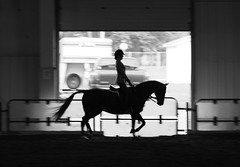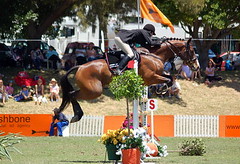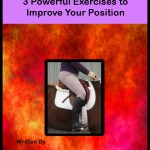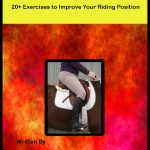Equitation – 5 Major Equitation Corrections
There are 5 major equitation positional corrections that instructors usually make. They are:
- Heels down – When looking at a rider in profile, the heel should be the lowest part of the foot. This is to engage your calf against the horse’s side as the primary source of getting the horse going. If you have to raise your heel up to get the horse to engage and move forward then your horse is not going forward properly.
 photo credit: andreavallejos
photo credit: andreavallejos
- Eyes Up/Head up – Holding your head up and eyes looking forward puts your entire body in the action and part of the riding process. If you drop your eyes down, your head, shoulders and upper body drops down as well. This simple act will destroy an otherwise lovely position and put your horse onto the forehand.
- Elbows bent– Keeping your elbows bent will permit a straight connection from your body to the horse’s mouth. Riding from your elbows permits you to ride from your core and keeps your hands and arms relaxed and in connection with your
 photo credit: GollyGforce (swamped season at work)
photo credit: GollyGforce (swamped season at work)

Keep Your Head Up horse. Mistakes to watch for are:
- straight arms right from the shoulder with out any bend in the elbow
- broken wrists
- flat hands – hands should be almost vertical with palms facing each other and hands a mirror image of each other
- Stiff had hands
- Shoulders back – Keeping your shoulders back helps to keep riders in balance. It is important to keep your shoulders level. Slouching through you rib cage will cause your shoulders to become unlevel. To prevent yourself from slouching, think of the distance from the bottom of your right rib cage to the top of your right hip as the same length as the bottom of your left rib cage to the top of your left hip. Make these distances the same and your shoulders will be level.
- Legs on – This does not mean squeeze the horse as hard as possible. It means keeping your legs relaxed against your horse’s sides so you can have your leg ready and available to give your horse a cue. Unnecessary gripping will result in a tense rider and a horse which becomes dead to the leg.
While riding if you keep these 5 tips in mind your equitation skills will sure to improve!
What is one correction that you need help with? Let us know and we can get some exercises for you.
~Laura

 Try these three powerful exercises to get strengthen your position.
Try these three powerful exercises to get strengthen your position.

Laura, Personally, I’d rephrase #3 to be the reverse – riding from the core allows you to bend your elbows, which then allows you to soften the arm joints (shoulders, elbows, wrists) and have a better connection to the horse.
There’s so much that corrects when riding from the core first, it’s amazing to me and I teach this!
I realize it’s hard for most people to see this, but this is what I do and suggest: Most people need to scoop their abs a little and do a little pelvic tuck. I realize that hunter position or two-point, everyone is going for the duck-tail look to avoid hunching the back. But I think that if you get into the basic position and then tuck the abs/pelvis as little as a 1/4 inch, you’ll see a difference. This stabilizes the core and, therefore, everything else.
With the core stabilized, you can now open the chest by lifting the breastbone and roll the shoulders back. Notice what that does for the elbows: They automatically come in (instead of poking out to the side). This then corrects flat hands!
Now add to this (I know, I know, too many things to remember to do and while riding too!) a ten-percent Kegel. What’s a Kegel? Well if you’ve had children the normal way (not a C-section), you know what that is. 🙂 If you haven’t, then imagine being at a party where there are no facilities for a mile and no place to hide and you’ve just drunk a six-pack of your favorite beverage. What muscles are you going to engage to make it through that 20-minute walk to the restroom/outhouse? I’m sure you’ve got it1
Now do just a ten-percent version, leaving your butt and thigh muscles soft and relaxed. Voila’! A relaxed and happy horse that’s listening to your body and you don’t have to haul around by its mouth!
Your horse knows if you do Pilates! 😀
Laurie Higgins of http://www.coreconnexxions.com, on FaceBook at Core Connections – Laurie Higgins, and my blog, https://coreconnexxions.wordpress.com/.
I hope that wasn’t too much of a shameless plug! 😀
I think people need to scoop their abs as well. I try to tell people that I would like to see the seam of their breeches more vertical and if I see the top of the seam of their breeches in front of the bottom seam of their breeches they are arching their back too much.
Interesting you mentioned keigel. I asked my most recent students to lift up their diaphram, and hold yourself like you have to pee. how else do you explain it?
Thank you for your lovely comments. I appreciate the opportunity to hear/see your explainations.
~Laura
Good quick tips on not only show ring performance but good riding. It’s funny, I was at a Denny Emerson clinic not too many years ago (he has a beautiful facility) and he used the term ‘tipping.’ Here I’m thinking my body’s crooked, but I ultimately discovered what he was trying point out was that my shoulders were getting ahead of my hips. Took looking at a picture a photographer had taken to realize that’s what he was getting at. Sometimes a picture really is worth a thousand words – or more. I’ve become a big believer of video taping rides (even if it’s just a tripod set up in the riding area) and have been amazed to discover how many suspected horse problems are actually rider error.
Yes video can be a real help when making positional corrections. That gives me a great idea for my next lesson/course doing video analysis!
Hm. I describe using the pelvic floor as holding in like you have to pee, yes. But I don’t add in lifting up the diaphragm. I want the Kegel to be only about 10% of a full-on tight one. It’s actually quite subtle.
The diaphragm thing. I’m not sure what you’re getting at, so I can’t really say. I want people to breathe properly and most people don’t – they breathe only in their upper chest. That’s stress breathing. I think that perhaps asking people to lift their diaphragm would get some breathing problems. If you’re going to ask for scooping bellies or lifting the diaphragm, make sure they know how to breathe into their lower back ribs so that they still have full lung volume and the use of all that precious air! 🙂
I do suggest tightening the lower abs, right around the belly button.
Photos are quite valuable! 🙂